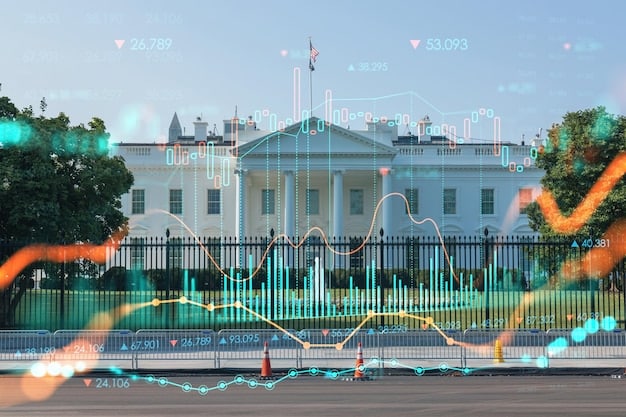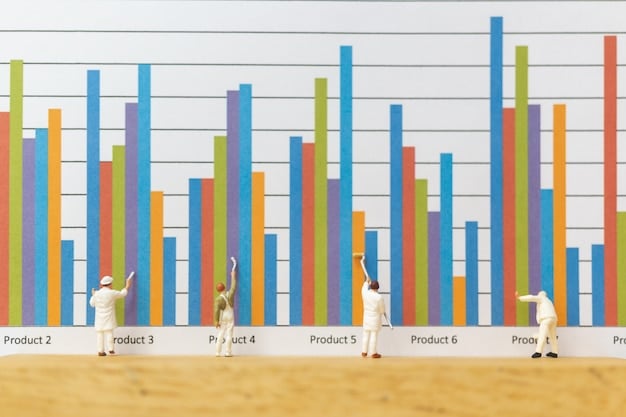Impact of Interest Rate Hikes: 2025 Stock Market Outlook

The Impact of Interest Rate Hikes on the Stock Market: A 2025 Outlook focuses on how potential interest rate increases by the Federal Reserve could influence investment strategies, market volatility, and overall economic growth in the United States.
Navigating the complexities of the stock market requires a keen understanding of various economic indicators, and few are as impactful as interest rate policies. This analysis, “The Impact of Interest Rate Hikes on the Stock Market: A 2025 Outlook,” delves into the anticipated effects of potential interest rate adjustments on the financial landscape. Understanding these dynamics is crucial for investors and stakeholders alike. The Impact of Interest Rate Hikes on the Stock Market: A 2025 Outlook requires examining historical trends and future projections.
Understanding Interest Rates and the Stock Market
Interest rates play a pivotal role in shaping the investment climate. They affect everything from borrowing costs for companies to the yields on fixed-income investments, which in turn influences stock valuations.
By examining the historical relationship between interest rate adjustments and market performance, we can derive valuable insights into what to expect in 2025.
How Interest Rates Affect Stock Prices
When interest rates rise, borrowing becomes more expensive for companies. This can lead to reduced capital expenditure, slower growth, and potentially lower earnings per share, making stocks less attractive.
The Investor’s Perspective
Rising interest rates often make bonds and other fixed-income investments more appealing due to higher yields. This can lead to a shift in investor sentiment away from stocks, putting downward pressure on equity prices.

- Bond Yields: Higher interest rates increase bond yields, drawing investors away from stocks.
- Corporate Borrowing: Rising rates increase borrowing costs, hindering corporate expansion and profitability.
- Investor Sentiment: Increased rates can lead to a bearish outlook, reducing overall market confidence.
In conclusion, the relationship between interest rates and the stock market is intricate. While higher rates can curb inflation, they often present headwinds for stock valuations, creating a challenging environment for investors.
Federal Reserve’s Stance and Potential Rate Hikes in 2025
The Federal Reserve’s monetary policy decisions loom large for the stock market. Understanding their stance and potential rate hikes requires a deep dive into the current economic conditions and forecasts.
The Fed’s actions are often guided by inflation targets, employment rates, and overall economic growth metrics.
Current Economic Conditions
As we approach 2025, key indicators such as inflation, unemployment, and GDP growth will heavily influence the Fed’s decisions. Surpassing or falling short of targets can trigger different policy responses.
Expert Predictions for 2025
Financial analysts and economists offer various predictions regarding the Fed’s likely course of action. These forecasts are based on complex models and analyses of economic trends.
- Inflationary Pressures: Persistent inflation may compel the Fed to raise rates aggressively.
- Employment Data: Strong job growth could signal the need for tighter monetary policy.
- Geopolitical Factors: Global events and uncertainties can complicate the Fed’s decision-making process.
In summary, the Federal Reserve’s decisions in 2025 will be pivotal in shaping the trajectory of the stock market. Investors should closely monitor economic data and expert analyses to anticipate potential shifts in monetary policy.
Historical Impact of Rate Hikes on Different Sectors
Different sectors of the stock market react differently to interest rate hikes. Examining historical data reveals patterns that can inform investment strategies.
Some sectors are more vulnerable to rising rates due to their reliance on borrowing and sensitivity to consumer spending.

Vulnerable Sectors
Sectors like real estate and utilities, which depend heavily on debt financing, often underperform when rates rise. Higher borrowing costs can curtail expansion and reduce profitability.
Resilient Sectors
On the other hand, sectors such as healthcare and consumer staples tend to be more resilient. These industries offer essential goods and services that are less sensitive to economic fluctuations.
Opportunities in a Rising Rate Environment
Financial stocks may benefit from higher interest rates, as they typically increase net interest margins for banks. This can lead to enhanced profitability and investor appeal.
- Financials: Banks and financial institutions may see increased profitability.
- Real Estate: Higher borrowing costs can dampen demand and slow growth.
- Utilities: Capital-intensive industries may face challenges due to higher debt costs.
In conclusion, understanding the differential impact of rate hikes across sectors is vital for strategic investment decisions. Diversifying portfolios and targeting resilient industries can help mitigate risk during periods of monetary tightening.
Strategies for Navigating Rate Hikes in Your Stock Portfolio
Navigating stock portfolios during periods of rising interest rates requires a proactive and informed approach. Investors can employ several strategies to mitigate risk and capitalize on potential opportunities.
Adapting investment strategies to account for rate hikes involves assessing current holdings, diversifying assets, and considering alternative investments.
Diversification Is Key
Diversifying across different sectors and asset classes can reduce exposure to rate-sensitive areas. Spreading investments helps to mitigate potential losses in any single sector.
Rebalancing Your Portfolio
Regularly rebalancing your portfolio ensures that it aligns with your risk tolerance and investment goals. This may involve reducing holdings in vulnerable sectors and increasing exposure to more resilient ones.
Considering Alternative Investments
Alternative investments such as real estate investment trusts (REITs) and commodities can provide diversification benefits and potentially hedge against inflation.
Investors need to adapt their strategies to stay flexible and informed, which may include consulting with financial advisors and staying updated on market trends.
The Impact of Global Economic Factors
Global economic factors can amplify or mitigate the impact of interest rate hikes on the US stock market. Understanding these interconnected dynamics is crucial for a well-rounded investment strategy.
Global economic health and monetary policies of other nations can significantly influence the overall market sentiment, trade dynamics, and capital flows.
International Trade Dynamics
Trade tensions and agreements can affect corporate earnings and investor confidence. Changes in tariffs and trade policies can create winners and losers among different companies and sectors.
Monetary Policies in Other Countries
The monetary policies of major economies, such as the European Union and China, can impact the US stock market. Divergent or coordinated approaches can create opportunities and risks for investors.
Geopolitical Risks
Geopolitical uncertainties, such as political instability and international conflicts, can lead to heightened market volatility. These events can disrupt supply chains and affect investor sentiment worldwide.
- Trade Policies: Changes in trade policies can affect corporate earnings and market sentiment.
- Global Monetary Policies: The actions of other central banks can influence capital flows and market stability.
- Geopolitical Instability: Political uncertainties can heighten market volatility and investor risk.
In summary, global economic factors play a significant role in shaping the impact of interest rate hikes on the US stock market. Investors should remain informed about international events and policies to make sound investment decisions.
Long-Term Investment Strategies vs. Short-Term Reactions
Distinguishing between long-term investment strategies and short-term market reactions is essential for successful navigation of interest rate hikes. Often, immediate market responses can be misleading.
Long-term investors should focus on fundamental factors and avoid knee-jerk reactions to short-term market fluctuations.
Focusing on Fundamentals
Assessing the underlying strengths and weaknesses of companies and sectors is critical. Strong balance sheets, competitive advantages, and growth potential are key indicators of long-term success.
Avoiding Emotional Decisions
Market volatility driven by rate hikes can trigger emotional responses and impulsive decisions. It’s vital to adhere to a well-thought-out investment plan and avoid panic selling or buying.
Dollar-Cost Averaging
Implementing a dollar-cost averaging strategy involves investing a fixed amount of money at regular intervals, regardless of market conditions. This approach can help to mitigate the impact of short-term volatility and potentially lower the average cost per share over time.
Strategic decisions during rising interest rates require a balanced approach. Staying disciplined, focusing on fundamentals, and maintaining a long-term perspective can lead to more profitable outcomes.
| Key Point | Brief Description |
|---|---|
| 📊 Interest Rates | Influence borrowing costs and stock valuations. |
| 🏦 Federal Reserve | Monetary policy drives market trends in 2025. |
| 📈 Sector Impact | Differential impact across market: vulnerable vs. resilient. |
| 🌐 Global Factors | Trade dynamics and geopolitical events affect stock market. |
Frequently Asked Questions
▼
Interest rate hikes often increase market volatility as investors reassess asset valuations and adjust their portfolios. Sectors highly reliant on debt financing may experience significant price swings.
▼
Sectors such as financials and consumer staples often perform relatively well during periods of rising interest rates. Financial institutions can benefit from increased net interest margins.
▼
Diversification across sectors, asset classes, and geographic regions can help mitigate risk. Rebalancing portfolios and considering alternative investments are also effective strategies.
▼
The Federal Reserve assesses various economic indicators, including inflation rates, employment data, and GDP growth, to determine the appropriate timing and magnitude of interest rate adjustments.
▼
Global economic factors, such as trade tensions, monetary policies of other countries, and geopolitical events, can amplify or mitigate the impact of interest rate hikes on the US stock market.
Conclusion
Understanding the potential impact of interest rate hikes on the stock market in 2025 is crucial for investors. By closely monitoring economic indicators, diversifying portfolios, and implementing strategic investment approaches, individuals can better navigate the complexities of a changing financial landscape.





